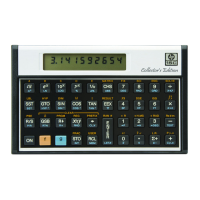Section 4: Statistics Functions 57
Keystrokes Display
70 ´ j
7.56
Predicted grain yield in
tons/hectare.
®
0.99
The original data closely
approximates a straight line.
Other Applications
Interpolation. Linear interpolation of tabular values, such as in
thermodynamics and statistics tables, can be carried out very simply on
the HP 15c by using the j function. This is because linear interpolation
is linear estimation: two consecutive tabular values are assumed to form
two points on a line, and the unknown intermediate value is assumed to
fall on that same line.
Vector Arithmetic. The statistical accumulation functions can be used to
perform vector addition and subtraction. Polar vector coordinates must
be converted to rectangular coordinates upon entry (θ, v, r, ;,
z). The results are recalled from R
3
(Σx) and R
5
(Σy) (using l z)
and converted back to polar coordinates, if necessary. Remember that for
polar coordinates the angle is between −180° and 180° (or −π and π
radians, or −200 and 200 grads). To convert to a positive angle, add 360
(or 2π or 400) to the angle.
For the second vector entered, the final keystroke will be either z or
w, depending on whether the two vectors should be added or
subtracted.

